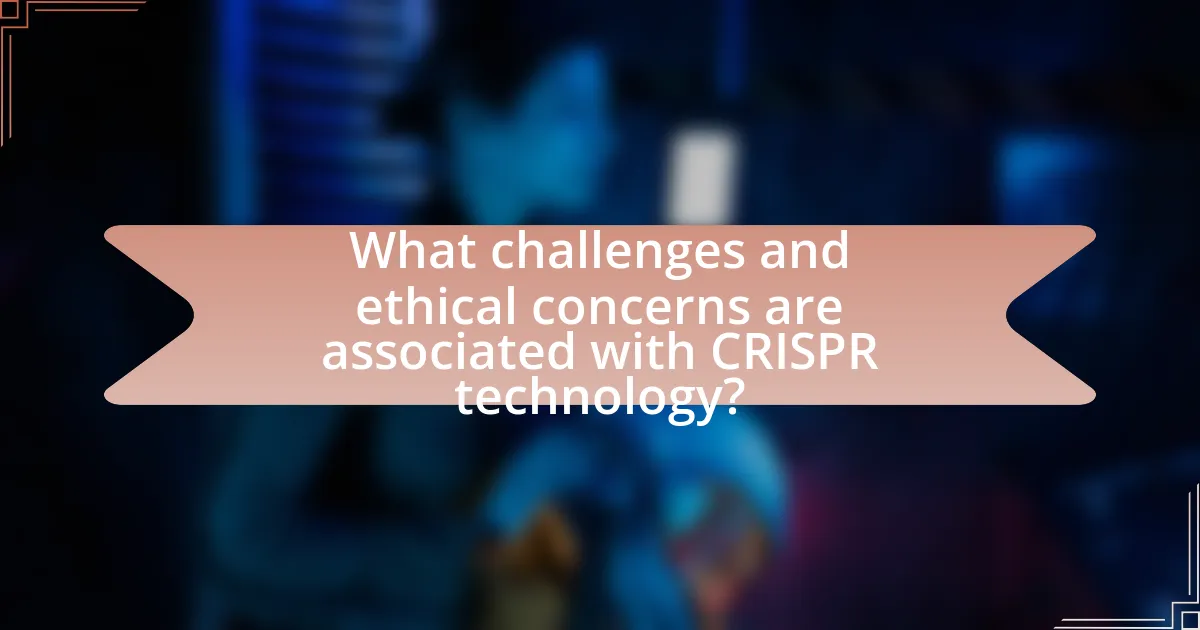CRISPR technology is a groundbreaking advancement in gene editing, enabling precise and efficient modifications of DNA sequences across various organisms. This article explores the mechanisms of CRISPR, particularly the CRISPR-Cas9 system, and its applications in medicine, agriculture, and biotechnology. Key components such as guide RNA and the Cas9 enzyme are discussed, along with the advantages of CRISPR over traditional gene editing methods. Additionally, the article addresses the ethical considerations and challenges associated with CRISPR technology, including off-target effects and the implications of germline editing. Overall, CRISPR’s transformative potential in addressing genetic disorders and enhancing agricultural practices is highlighted.

What is the Role of CRISPR Technology in Gene Editing Advancements?
CRISPR technology plays a pivotal role in gene editing advancements by providing a precise and efficient method for altering DNA sequences in various organisms. This technology, derived from the natural defense mechanisms of bacteria, allows scientists to target specific genes for modification, enabling applications such as disease treatment, agricultural improvements, and biological research. For instance, studies have demonstrated that CRISPR can effectively edit genes associated with genetic disorders, as seen in research published in “Nature” by Doudna and Charpentier, who were instrumental in developing the CRISPR-Cas9 system. This advancement has revolutionized the field of genetics, making gene editing more accessible and cost-effective compared to previous methods.
How does CRISPR technology function in gene editing?
CRISPR technology functions in gene editing by utilizing a guide RNA to direct the Cas9 enzyme to a specific DNA sequence, where it creates a double-strand break. This targeted break allows for the disruption of genes or the insertion of new genetic material, enabling precise modifications. The mechanism relies on the natural defense system of bacteria, which use CRISPR to recognize and cut foreign DNA. Studies have demonstrated the effectiveness of CRISPR in various organisms, showcasing its potential for applications in medicine, agriculture, and biotechnology.
What are the key components of CRISPR technology?
The key components of CRISPR technology are the CRISPR-associated protein 9 (Cas9), guide RNA (gRNA), and the target DNA sequence. Cas9 is an endonuclease that introduces double-strand breaks in DNA, while gRNA directs Cas9 to the specific location in the genome by complementary base pairing with the target DNA sequence. This mechanism allows for precise editing of genes, which has been demonstrated in various studies, including research published in “Science” by Doudna and Charpentier in 2012, where they outlined the functionality of these components in gene editing.
How does the CRISPR-Cas9 system specifically edit genes?
The CRISPR-Cas9 system specifically edits genes by utilizing a guide RNA to direct the Cas9 enzyme to a precise location in the DNA sequence, where it creates a double-strand break. This break activates the cell’s natural repair mechanisms, which can be harnessed to introduce specific genetic changes, such as insertions or deletions. The accuracy of this gene-editing process is supported by the ability of the guide RNA to match the target DNA sequence, ensuring that the Cas9 enzyme acts only at the intended site, thereby minimizing off-target effects.
Why is CRISPR technology considered a breakthrough in gene editing?
CRISPR technology is considered a breakthrough in gene editing because it allows for precise, efficient, and cost-effective modifications to DNA. This technology utilizes a guide RNA to direct the Cas9 enzyme to specific locations in the genome, enabling targeted cuts and subsequent alterations. The simplicity and versatility of CRISPR have led to its rapid adoption in various fields, including medicine, agriculture, and biological research, significantly advancing the capabilities of genetic engineering. For instance, studies have demonstrated CRISPR’s effectiveness in creating genetically modified organisms and potential therapies for genetic disorders, showcasing its transformative impact on the field of genetics.
What advantages does CRISPR offer over traditional gene editing methods?
CRISPR offers several advantages over traditional gene editing methods, primarily its precision, efficiency, and cost-effectiveness. Unlike older techniques such as zinc-finger nucleases and TALENs, CRISPR utilizes a simple RNA-guided mechanism that allows for targeted modifications in the genome with high accuracy. This precision reduces off-target effects, which are common in traditional methods, thereby enhancing the reliability of genetic modifications. Additionally, CRISPR is significantly faster and easier to design, enabling researchers to edit genes in a matter of weeks rather than months. The cost of CRISPR technology is also lower, making it accessible for a wider range of applications in research and medicine. These advantages have been demonstrated in various studies, including a 2016 paper published in Nature Biotechnology, which highlighted CRISPR’s superior efficiency in gene editing compared to previous methods.
How has CRISPR technology impacted research and development in genetics?
CRISPR technology has significantly transformed research and development in genetics by enabling precise gene editing with unprecedented efficiency and accuracy. This advancement allows scientists to modify DNA sequences in living organisms, facilitating breakthroughs in understanding genetic diseases, developing new therapies, and enhancing agricultural practices. For instance, studies have demonstrated that CRISPR can effectively target and edit genes associated with conditions like sickle cell anemia and muscular dystrophy, leading to potential treatments that were previously unattainable. Additionally, the technology has accelerated the pace of genetic research, as evidenced by the rapid increase in publications and patents related to CRISPR applications since its introduction in 2012.

What are the applications of CRISPR technology in various fields?
CRISPR technology has diverse applications across various fields, including medicine, agriculture, and biotechnology. In medicine, CRISPR is utilized for gene therapy to treat genetic disorders such as sickle cell anemia and cystic fibrosis by directly editing the faulty genes. In agriculture, CRISPR enhances crop resilience and yields by creating genetically modified organisms that can withstand pests and environmental stressors, as demonstrated by the development of disease-resistant rice varieties. Additionally, in biotechnology, CRISPR is employed for synthetic biology applications, enabling the design of microorganisms for biofuel production and bioremediation. These applications illustrate CRISPR’s transformative potential in addressing critical challenges in health, food security, and environmental sustainability.
How is CRISPR technology utilized in medicine?
CRISPR technology is utilized in medicine primarily for gene editing to treat genetic disorders, enhance cancer therapies, and develop personalized medicine. This technology allows precise modifications to DNA, enabling the correction of mutations responsible for diseases such as cystic fibrosis and sickle cell anemia. For instance, clinical trials have demonstrated the effectiveness of CRISPR in editing genes to produce functional hemoglobin in patients with sickle cell disease, leading to significant health improvements. Additionally, CRISPR is being explored in immunotherapy to enhance the body’s immune response against tumors, with studies indicating increased efficacy in targeting cancer cells.
What are the potential therapeutic applications of CRISPR in treating genetic disorders?
CRISPR technology has potential therapeutic applications in treating genetic disorders by enabling precise gene editing to correct mutations responsible for these conditions. For instance, CRISPR has been utilized in clinical trials to target and modify genes associated with diseases such as sickle cell anemia and beta-thalassemia, demonstrating the ability to restore normal function in hematopoietic stem cells. Research published in the New England Journal of Medicine by Frangoul et al. (2021) showed that patients with sickle cell disease experienced significant clinical improvement after CRISPR-based treatment, highlighting its effectiveness. Additionally, CRISPR holds promise for addressing a wide range of genetic disorders, including muscular dystrophy and cystic fibrosis, by directly repairing or replacing faulty genes.
How does CRISPR contribute to advancements in cancer research?
CRISPR contributes to advancements in cancer research by enabling precise gene editing, which allows scientists to investigate the genetic mutations that drive cancer. This technology facilitates the creation of cancer models that mimic human tumors, providing insights into tumor biology and potential therapeutic targets. For instance, studies have demonstrated that CRISPR can be used to knock out specific genes associated with cancer progression, leading to a better understanding of their roles in tumor development. Additionally, CRISPR-based approaches are being explored for developing targeted therapies, such as CAR-T cell therapies, which have shown promise in treating certain types of cancer.
What role does CRISPR play in agriculture?
CRISPR plays a transformative role in agriculture by enabling precise gene editing to enhance crop traits such as yield, disease resistance, and stress tolerance. This technology allows scientists to modify specific genes in plants, leading to the development of varieties that can withstand environmental challenges and improve food security. For instance, research has demonstrated that CRISPR can be used to create rice varieties with increased resistance to bacterial blight, a significant threat to global rice production. Additionally, CRISPR has been employed to enhance the nutritional content of crops, such as increasing the levels of essential vitamins in staple foods. These advancements illustrate CRISPR’s potential to revolutionize agricultural practices and address pressing global food challenges.
How can CRISPR technology improve crop resilience and yield?
CRISPR technology can improve crop resilience and yield by enabling precise genetic modifications that enhance traits such as drought tolerance, pest resistance, and nutrient efficiency. For instance, researchers have successfully used CRISPR to edit genes in rice to increase its resistance to bacterial blight, resulting in higher yields under disease pressure. Additionally, a study published in Nature Biotechnology demonstrated that CRISPR-edited crops can achieve better water use efficiency, which is crucial for maintaining productivity in arid conditions. These advancements illustrate how CRISPR can directly contribute to sustainable agriculture by increasing crop performance in challenging environments.
What ethical considerations arise from using CRISPR in food production?
The ethical considerations arising from using CRISPR in food production include concerns about biodiversity, potential health risks, and socio-economic impacts. Biodiversity may be threatened as genetically modified organisms could outcompete native species, leading to ecological imbalances. Potential health risks involve the long-term effects of consuming CRISPR-modified foods, which remain largely unstudied, raising questions about food safety. Socio-economic impacts include the risk of monopolization of seed patents by large corporations, which could disadvantage small farmers and reduce agricultural diversity. These considerations highlight the need for careful regulation and public discourse surrounding CRISPR technology in food production.

What challenges and ethical concerns are associated with CRISPR technology?
CRISPR technology faces significant challenges and ethical concerns, primarily related to off-target effects, potential misuse, and the implications of germline editing. Off-target effects occur when CRISPR inadvertently alters unintended parts of the genome, which can lead to harmful consequences, as evidenced by studies showing that up to 20% of edits may not be precise. The potential misuse of CRISPR raises fears about bioweapons or designer babies, prompting calls for regulatory frameworks to prevent unethical applications. Additionally, germline editing, which affects future generations, poses profound ethical dilemmas regarding consent and the long-term impact on human evolution, as highlighted by the controversy surrounding the 2018 case of a scientist who created genetically edited twins in China. These challenges necessitate ongoing dialogue among scientists, ethicists, and policymakers to navigate the complex landscape of CRISPR technology responsibly.
What are the potential risks of using CRISPR technology?
The potential risks of using CRISPR technology include off-target effects, where unintended parts of the genome are altered, and ethical concerns regarding germline editing, which can affect future generations. Off-target effects can lead to unintended mutations that may cause harmful consequences, as demonstrated in studies where CRISPR altered genes other than the intended target, potentially leading to diseases or malfunctions. Ethical concerns arise from the possibility of creating “designer babies” and the implications of altering human genetics, which raises questions about consent and the long-term effects on human evolution.
How can off-target effects impact gene editing outcomes?
Off-target effects can significantly impact gene editing outcomes by causing unintended modifications to the genome, which may lead to harmful consequences. These unintended edits can disrupt essential genes or regulatory elements, potentially resulting in adverse phenotypic changes or diseases. For instance, studies have shown that CRISPR-Cas9, a widely used gene editing tool, can have off-target activity that affects up to 20% of unintended sites, leading to unpredictable biological effects. This highlights the importance of improving specificity in gene editing technologies to minimize off-target effects and ensure safer applications in therapeutic contexts.
What measures are in place to ensure safe use of CRISPR technology?
Regulatory frameworks and ethical guidelines are in place to ensure the safe use of CRISPR technology. Organizations such as the National Institutes of Health (NIH) and the Food and Drug Administration (FDA) in the United States oversee research and clinical applications, requiring rigorous review processes for any proposed gene editing experiments. Additionally, international bodies like the World Health Organization (WHO) provide guidelines that emphasize safety and ethical considerations, including the potential ecological impacts and long-term effects on human health. These measures are supported by ongoing research and public engagement to address societal concerns and ensure responsible use of CRISPR technology.
What ethical dilemmas does CRISPR technology present?
CRISPR technology presents several ethical dilemmas, primarily concerning genetic modification, consent, and potential misuse. The ability to edit genes raises questions about the morality of altering human embryos, which could lead to unintended consequences and the creation of “designer babies.” Additionally, the lack of informed consent from future generations complicates the ethical landscape, as individuals cannot agree to modifications made before their birth. Furthermore, the potential for CRISPR to be used in bioweapons or for enhancing human capabilities poses significant risks, highlighting the need for strict regulations and ethical guidelines in its application.
How do societal views influence the regulation of CRISPR applications?
Societal views significantly influence the regulation of CRISPR applications by shaping public perception and policy decisions. For instance, concerns about ethical implications, such as potential misuse in human germline editing, lead to stricter regulatory frameworks in many countries. In 2015, the International Summit on Human Gene Editing highlighted global apprehensions regarding safety and ethical considerations, prompting calls for governance that reflects societal values. Additionally, public opinion can drive legislative action; surveys indicate that acceptance of gene editing technologies varies widely, affecting how governments approach regulation. Thus, societal attitudes directly impact the pace and nature of CRISPR application regulations.
What are the implications of germline editing in humans?
Germline editing in humans has significant implications, including the potential to eliminate genetic disorders and enhance desirable traits. This technology allows for modifications to be passed down to future generations, which raises ethical concerns regarding eugenics and unintended consequences on human evolution. Studies, such as those published in the journal Nature, highlight the risks of off-target effects and the unknown long-term impacts on the human gene pool. Furthermore, regulatory frameworks are still developing, leading to debates about safety, accessibility, and the moral responsibilities of scientists and society.
What best practices should researchers follow when using CRISPR technology?
Researchers should follow best practices such as thorough planning, precise design of guide RNAs, and rigorous validation of CRISPR edits. Thorough planning involves defining clear objectives and understanding the biological context of the target genes. Precise design of guide RNAs is crucial, as studies show that optimal guide RNA design can significantly enhance editing efficiency and reduce off-target effects. Rigorous validation of CRISPR edits is essential to confirm that the intended modifications have been made accurately, which can be achieved through techniques like Sanger sequencing or next-generation sequencing. These practices are supported by research indicating that adherence to these guidelines improves the reliability and safety of CRISPR applications in gene editing.
How can researchers minimize risks associated with CRISPR editing?
Researchers can minimize risks associated with CRISPR editing by implementing rigorous off-target analysis and using advanced techniques such as high-fidelity Cas9 variants. Off-target analysis involves assessing potential unintended edits in the genome, which can be achieved through methods like whole-genome sequencing or targeted deep sequencing. High-fidelity Cas9 variants, such as SpCas9-HF1, have been engineered to reduce off-target effects while maintaining editing efficiency. Studies have shown that these approaches significantly decrease the likelihood of unintended genetic modifications, thereby enhancing the safety profile of CRISPR applications in research and therapy.
What guidelines exist for ethical CRISPR research and application?
Ethical guidelines for CRISPR research and application include the principles established by organizations such as the National Academy of Sciences and the World Health Organization. These guidelines emphasize the importance of safety, transparency, and public engagement in gene editing practices. For instance, the National Academy of Sciences recommends rigorous risk assessments and the necessity of obtaining informed consent from participants involved in research. Additionally, the World Health Organization advocates for global collaboration to ensure equitable access to CRISPR technologies and to address ethical concerns related to germline editing. These guidelines aim to promote responsible use of CRISPR while minimizing potential risks and societal implications.


